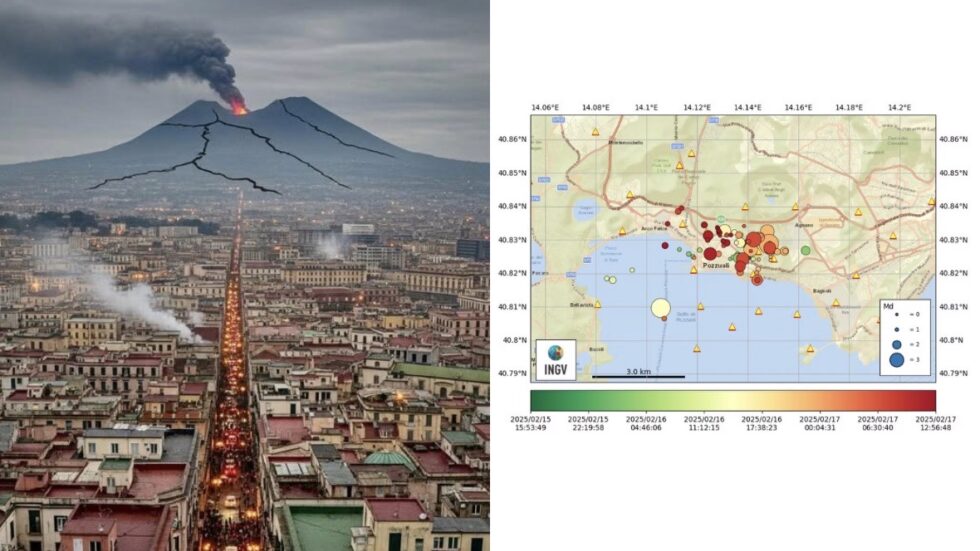Earthquakes Shake Naples as Italy’s Supervolcano Campi Flegrei Shows Renewed Activity

A 4.0-magnitude earthquake struck the volcanic region near Mount Vesuvius in Naples, Italy, early Friday morning, July 18, 2025, shaking the Campi Flegrei caldera and prompting a series of aftershocks into July 19. The epicenter was located offshore near Pozzuoli, in the heart of one of Europe’s most dangerous and densely populated volcanic zones. Although no injuries or major damage have been reported, the event triggered renewed public concern and increased scientific monitoring of the area’s seismic and volcanic behavior.
Authorities confirm multiple tremors, and scientists warn of ongoing ground uplift and sustained volcanic gas emissions in the region.
G.Business reports on the developments based on data from Italy’s National Institute for Geophysics and Volcanology (INGV)), local authorities, and scientific experts.
What Happened
At 9:14 a.m. local time, seismic instruments recorded a shallow earthquake at approximately 2.5 km depth. The shock was widely felt across Naples and surrounding towns, prompting precautionary evacuations. Train services on the Cumana and Circumflegrea lines were temporarily halted, and the Campi Flegrei Archaeological Park was closed pending safety inspections.
On July 19, four additional tremors were recorded, including a magnitude 1.9 earthquake at 12:22 p.m., confirming continued unrest beneath the caldera.
What Is Bradisism and Why Is It Critical
The Campi Flegrei caldera, which last erupted in 1538, is undergoing bradisism – a gradual uplift of the ground caused by the accumulation of magma and volcanic gases beneath the surface. According to INGV, ground deformation in the Rione Terra zone is rising at about 1.5 cm per month, and gas emissions remain elevated.
“This earthquake was also felt in the Vesuvian area, but no damages have been reported. Ground uplift and degassing continue at the same rate as previous months,” said Mauro Di Vito, director of the Osservatorio Vesuviano (MeteoWeb).
Local official Edoardo Cosenza added, “Public buildings are being inspected, but no serious structural issues are expected. The event occurred along a known undersea fault near Pozzuoli.” (Il Fatto Quotidiano)
Why It Matters Globally
Campi Flegrei is classified as a supervolcano, with the potential for continent-wide impact. Scientists around the world monitor this site closely, as calderas like this are known for sudden escalations following long periods of silence.
This month, several other volcanoes have shown signs of awakening:
- Kīlauea, Hawaii – Lava fountains return
- Reykjanes, Iceland – Magma moving near Grindavík
- Popocatépetl, Mexico – Explosive ash plumes
- Taal, Philippines – Elevated gas emissions
What Residents and Tourists Should Know
Italy’s Civil Protection Agency has reaffirmed that the area remains under yellow alert, a status in place since 2012. Emergency plans exist for the evacuation of up to 500,000 people if activity increases.
Tourists are advised to:
- Stay informed via INGV and local civil protection updates
- Avoid the “red zone” (Pozzuoli, Bacoli) during active periods
- Remain in central Naples or nearby coastal zones (Amalfi, Sorrento), considered safe for now
Seismic Events Summary (July 18–19, 2025)
| Date | Time | Magnitude | Depth (km) | Epicenter |
|---|---|---|---|---|
| July 18 | 09:14 | 4.0 | 2.5 | Pozzuoli (offshore) |
| July 19 | 00:29 | 1.6 | 3.0 | Campi Flegrei |
| July 19 | 01:03 | 1.1 | 2.6 | Campi Flegrei |
| July 19 | 12:22 | 1.9 | 3.2 | Pozzuoli |
Source: INGV Terremoti
For now, no eruption is imminent — but authorities and researchers are watching closely. As Europe’s only supervolcano remains active, both residents and visitors are urged to stay alert and informed.
Stay connected for news that works — timely, factual, and free from opinion — and insights that matter now: Storm hits northern Italy: Woman killed near Milan – widespread damage reported in several regions